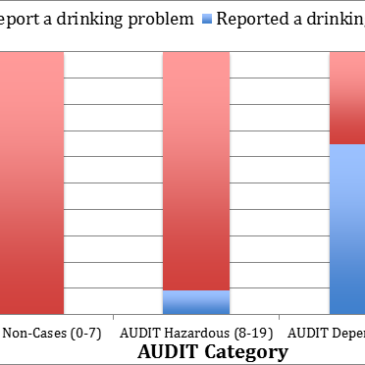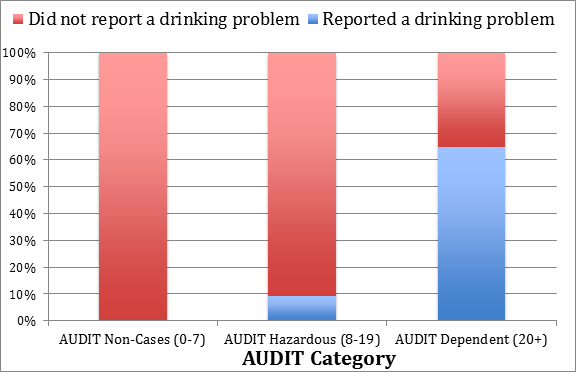Earlier in this Special Series, we have noted the lack of evidence-based treatment services for incarcerated people experiencing substance use disorders (SUD). When administrators at jails and prisons do decide to provide access to SUD treatment services, they must find a way to identify which prisoners need and will respond to these services. Today, The DRAM reports on a study that evaluated standard practices for identifying incarcerated people with SUD treatment needs (Kissell et al., 2014).
Methods
- The researchers sampled from 555 men who were eligible for the study because they were awaiting trial in one of three sampled prisons in the UK.
- Of these, 257 (46%) agreed to participate. The mean age of respondents was 26.5 years.
- Participants completed the Alcohol Use Disorders Identification Test (AUDIT; Saunders, Aasland, Barbot, de la Fuente, & Grant, 1993), which asks 10 questions to classify respondents as (1) not cases (scores of 0-7), (2) hazardous drinkers (scores of 8-19), or (3) dependent drinkers (scores of 20+).
- Participants also answered questions designed to reflect routine practice for identifying those in need of treatment, including Do you think you had a problem with alcohol when you came into prison?
- In a follow-up interview about 28 days later, 170 participants (66% of the 257 who initially participated) indicated whether they had received any help during their first three weeks of imprisonment from a case worker representing a prison-based substance use treatment program.
Results
- Drinking problems were highly prevalent among this sample. According to the AUDIT, 19% of participants were non-cases, 42% were hazardous drinkers, and 39% were dependent.
- However, only about 9% of participants in the hazardous drinking category reported having a drinking problem when they came to prison, and only about 65% of participants in the dependent category did so (see Figure 1).
- Only 25% of participants classified as hazardous or dependent drinkers reported receiving help from a designated case worker. Among those who did not see a case worker, an unspecified proportion received medication for the symptoms of withdrawal but no other treatment services.
Figure 1. Patterns of responses to the question Do you think you had a problem with alcohol when you came into prison? as a function of AUDIT category
Limitations
- This study was limited by a low recruitment rate and sample demographics.
- Only about 46% of eligible participants completed the primary interview, and only 66% of those were imprisoned long enough to complete the follow-up interview.
- Only men were included.
- It is unclear whether the results can be generalized to the broader prison population, including women.
- This study was limited to the period before trial, conviction, or sentencing, which lasts about 28 days. This study cannot speak to the effects of prison-based treatment for alcohol abuse or dependence on quality of life, substance use, recidivism, or other important outcomes.
Conclusions
This study suggests that incarcerated people need to complete validated, standardized tools in order for staff to identify those who need help for drinking problems. Fully one third of participants who were dependent on alcohol (according to the AUDIT) did not report having a problem; nearly all of hazardous drinkers failed to report having a problem. Perhaps as a result, only a minority of prisoners with alcohol problems received counseling, assessment, and referral services. Administrators at correctional facilities must deploy more resources to identify and respond to the need for high-quality substance abuse treatment.
–Heather Gray
What do you think? Please use the comment link below to provide feedback on this article.
Reference
Kissell, A., Taylor, P. J., Walker, J., Lewis, E., Hammond, A., & Amos, T. (2014). Disentangling Alcohol-Related Needs Among Pre-trial Prisoners: A Longitudinal Study. Alcohol Alcohol. doi: 10.1093/alcalc/agu056
Saunders, B. J., Aasland, O. G., Barbot, T. F., de la Fuente, J. R., & Grant, M. (1993). Development of the alcohol use disorders identification test (AUDIT): WHO collaborative project on early detection of persons with harmful alcohol consumption: II. Addiction, 88, 791-804.





